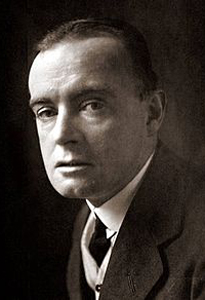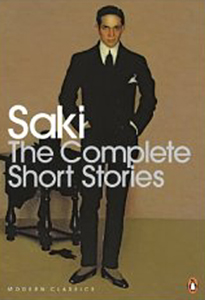
photo by Brittanie Pendleton
by Alex Mair
Saki was a strange beast, but genius is often strange. Everyone who loves short-stories will eventually get around to the work of Hector Hugo Munro, better known by his literary non-de-plume, Saki. Munro is that most curious of literary animals: the writer whose work is not as well known as it might be, but whose fingerprints can be found everywhere on the literary landscape. From The League of Gentlemen to the stories of Roald Dahl – another master of the macbre, with whom Munro shares a certain literary kinship – his legacy is on display in every satirical writer who has attempted to combine the maximum amount of cruelty with the minimum amount of mercy.
 Between 1900 and 1914, Munro established himself as one of the most innovative short-story writers of his time. His satirical joie de vivre brought him fame and notoriaty during his life, however his work is somewhat overlooked today. The comparison with Dahl is apposite. During his lifetime, Munro published short, economical and brilliantly funny stories satirising English social life at the turn of the century. In these remarkable short stories, he skillfully dissected the complacency of the Edwardian middle-classes.
Between 1900 and 1914, Munro established himself as one of the most innovative short-story writers of his time. His satirical joie de vivre brought him fame and notoriaty during his life, however his work is somewhat overlooked today. The comparison with Dahl is apposite. During his lifetime, Munro published short, economical and brilliantly funny stories satirising English social life at the turn of the century. In these remarkable short stories, he skillfully dissected the complacency of the Edwardian middle-classes.
To dip into a Munro story is to step across the threshold of good taste, and enter into a darkly satirical universe; one filled with strange beasts, terrifying aunts, blood-thirsty animals, talking hens and angry, unyeilding, god-like weasals. All of them animated by Munro’s voice; as wickedly cruel as it is unremittingly funny. Tom Sharpe writes of this in the introduction to The Best of Saki:
Step out through the French windows and you are in the realm of Pan and liable, unless you pay homage, to pay with your life for your arrogant belief in material progress and the virtues of middle-class respectability.
What is the continuing appeal of these deliciously mean and horribly addictive stories? Perhaps it is because Munro does what all truly great writers do; he inhabits his own singular world. Arthur Conan Doyle has his fog-bound London. John Updike has his Pennsylvania suburbs and car lots. Munro’s world is an Edwardian one. Time and again he returned to the same settings and themes. But his subject was always the Edwardian era. That apparently noble time before the First World War, embodied by it’s lust-loving and self-indulgent King, Edward VII. Judging from the ever popular television and film depictions of the period, Edwardian Britain seems to have taken on a rosy, sunlit glow in the collective psyche. It is as if the whole of the Edwardian era was nothing more than a long, extended, Indian summer, complete with the sound of clinking teacups and tennis matches on the lawn.
It was the Edwardians who threw off stuffy Victorian values and introduced a new era of liberalism. Among the things they campaigned for were votes for women, new trade union rights, and there was a new force in British politics, the Independent Labour Party. The new tabloid press was dominated by stories about Irish home rule and parliamentary giants like Winston Churchill and David Lloyd George. It was the time of Rolls and Royce, Conrad and Lawrence, the Wright Brothers and Shakleton, Elgar, H.G. Wells, and George Barnard Shaw.
Munro deconstructs the Edwardian family unit through humour and surrealism. In ‘Sredni Vashtar’, the hero, Conradin, is a ten-year-old boy who is looked after by a cold and hypocritical aunt. Munro makes the aunt’s character clear:
Mrs. DeRopp would never, in her honest moments, have confessed to herself that she disliked Conradin, though she might have been dimly aware that thwarting him ‘for his own good’ was a duty she did not find particularly irksome. Conradin hated her with a desperate sincerity which he was perfectly able to mask.
The aunt is made to pay dearly for her cruelty and hypochondria. The boy comes into possession of a ferret who he adopts as a pet. The animal later begins to display god-like properties and the boy, who is fond of the creature, begins to worship his new pet as a deity. Soon Conradin gets his revenge on his aunt. He prays to Shredi Vashtar and the loyal pet kills the aunt. The story ends with one of the most famous last lines of any Munro story: ‘And meanwhile Conradin calmly made himself another slice of toast.’
Mothers and aunts get a rough ride in Munro’s stories. Perhaps it was an austere, Victorian childhood that gave him his cruel streak.Born in Burma in 1870, the young Munro was the born into a colonial family, his father being a senior official in the Burmese police. Munro received what would have been described at the time as a ‘conventional upbringing’ – in terms of roughly seven per cent of the population. A sickly child and prone to illness, he was brought up, as many of these ‘conventional’ children were, by an aunt. His literary career got off to an unusual start with The Decline and Fall of the Russian Empire. A history of pre-revolutionary Russia might seem an odd way to begin a literary career. Odder still, then, that the scholar of Russian history should end by writing dark satirical tales. In the meantime, journalism provided him with some stability and the opportunity for foreign travel – he returned to London and began working for the Westminster Gazette. He was twenty-six when he began publishing the short stories for which he is now known.
 Munro was a talented writer with a keen satirical eye, but what is it that makes him a truly great satirist, as opposed to simply a good one?
Munro was a talented writer with a keen satirical eye, but what is it that makes him a truly great satirist, as opposed to simply a good one?
Perhaps it is Munro’s meanness. For all their enormous gifts, his contemporaries H.G. Wells and E.M. Forster were essentially optimists, Wells in particular believed in the benefits of material advancement. Munro, on the other hand, mocks the naïvety of belief in progress and the triumph of middle-class values. It is this cruelty and sheer pleasure derived from mockery that might explain why Munro remains something of an obscurity.
As we have seen, Mrs. DeRopp, the fearsome aunt of ‘Sredni Vastar’, comes to a sticky end at the hands of a sensitive child, who is her superior in intelligence and creativity. Munro’s satirical aims are evidenced again in ‘Tobermory’.
“What do you think of human intelligence?” asked Mavis Pellington lamely.
“Of whose intelligence in particular?” asked Tobermory coldly.
“Oh, well, mine for instance,” said Mavis with a feeble laugh
“You put me in an embarrassing position,” said Tobermory, whose tone and attitude certainly did not suggest a shred of embarrassment. “When your inclusion in this house party was suggested, Sir Wilfred protested that you were the most brainless woman of his acquaintance, and that there was a wide distinction between hospitality and the care of the feeble-minded.”
The stories are time capsules, taking us back to a less enlightened age, before feminism, the Holocaust and the Second World War forced a radical change in attitudes. Part of Munro seems comfortable in the prejudices of his class, which possibly goes someway to explain his decision to enlist in the trenches in the First World War, perhaps. Like all great satirists, Munro was partly in love with the world he despised and in a final paradox died fighting for the empire he had ridiculed.
Like many young men of his class and character, Munro enlisted at the earliest possible opportunity. In November 1916, he was killed near the village of Beaumont-Hamel on the river Somme. A German bullet hit him in the temple. The writer known to the world as Saki died in the most Munro-esque fashion. His last words were: “put that bloody cigarette out”.

